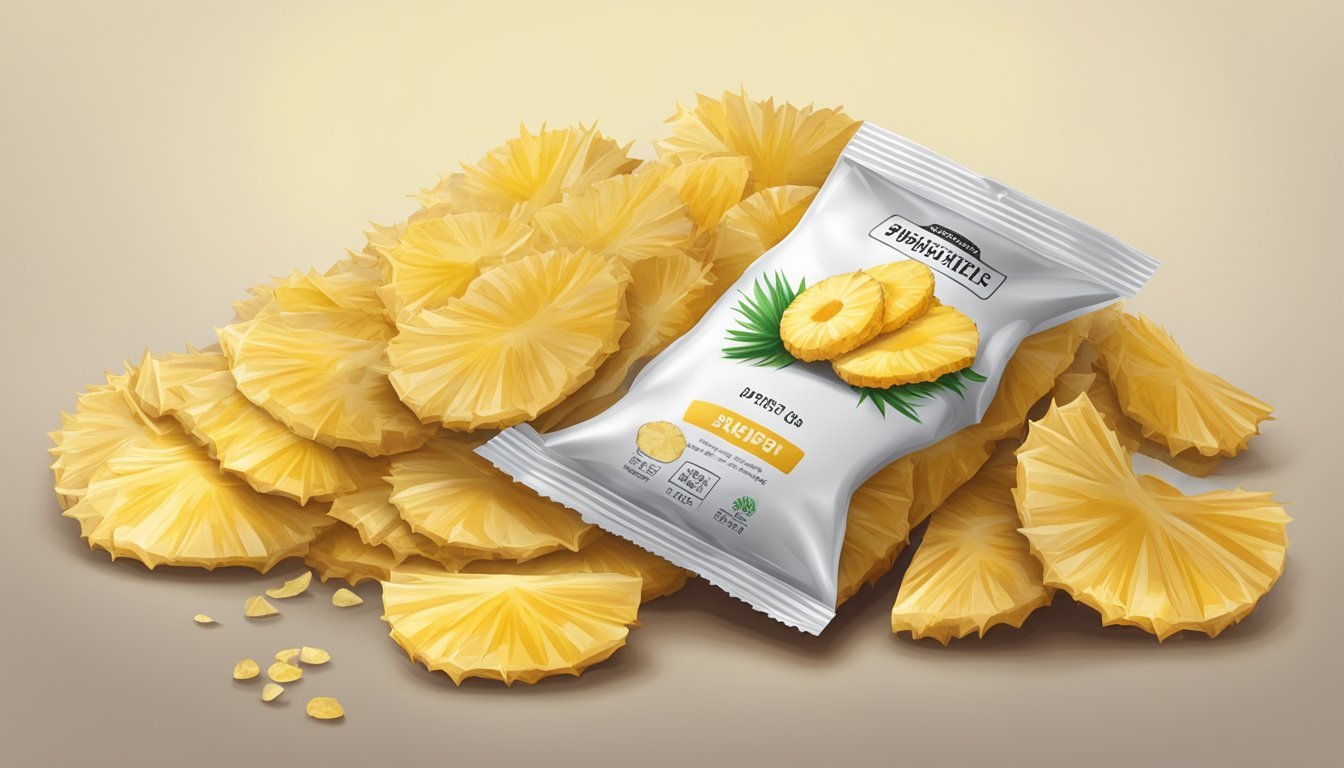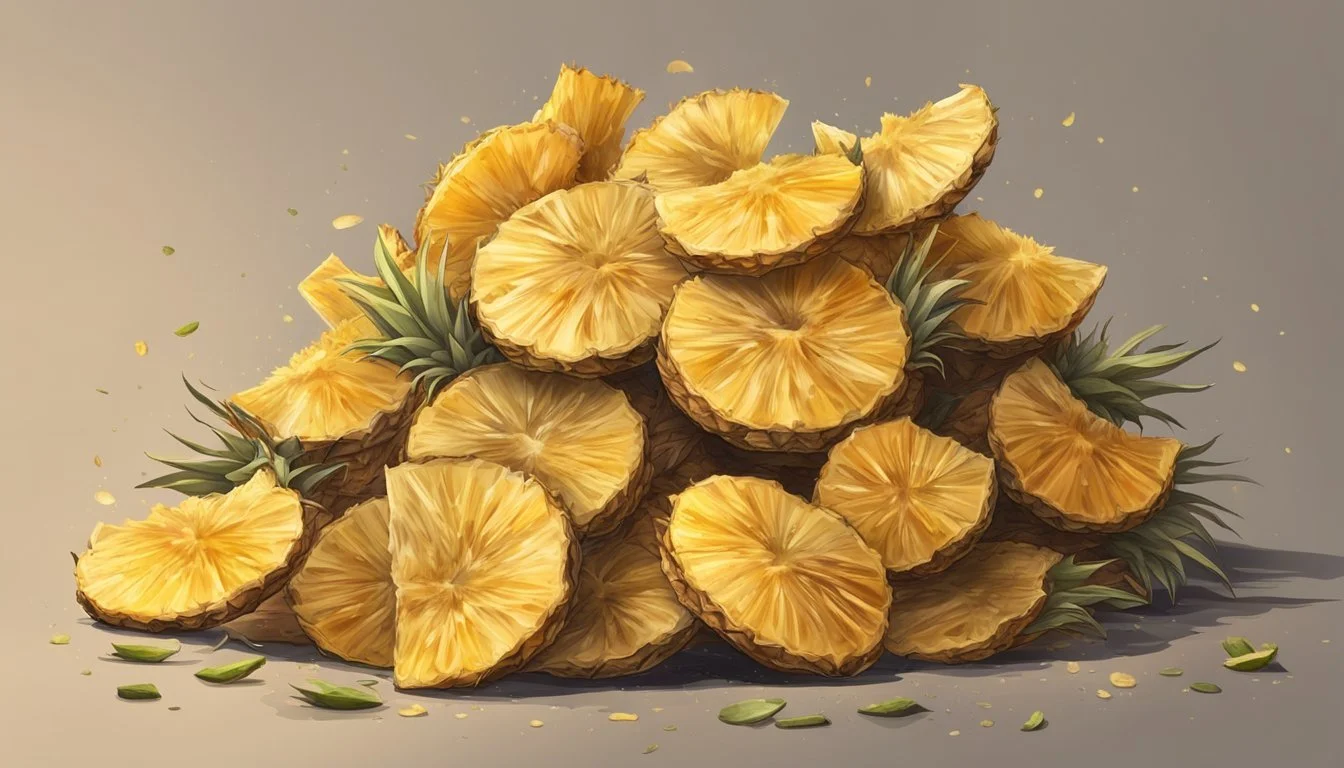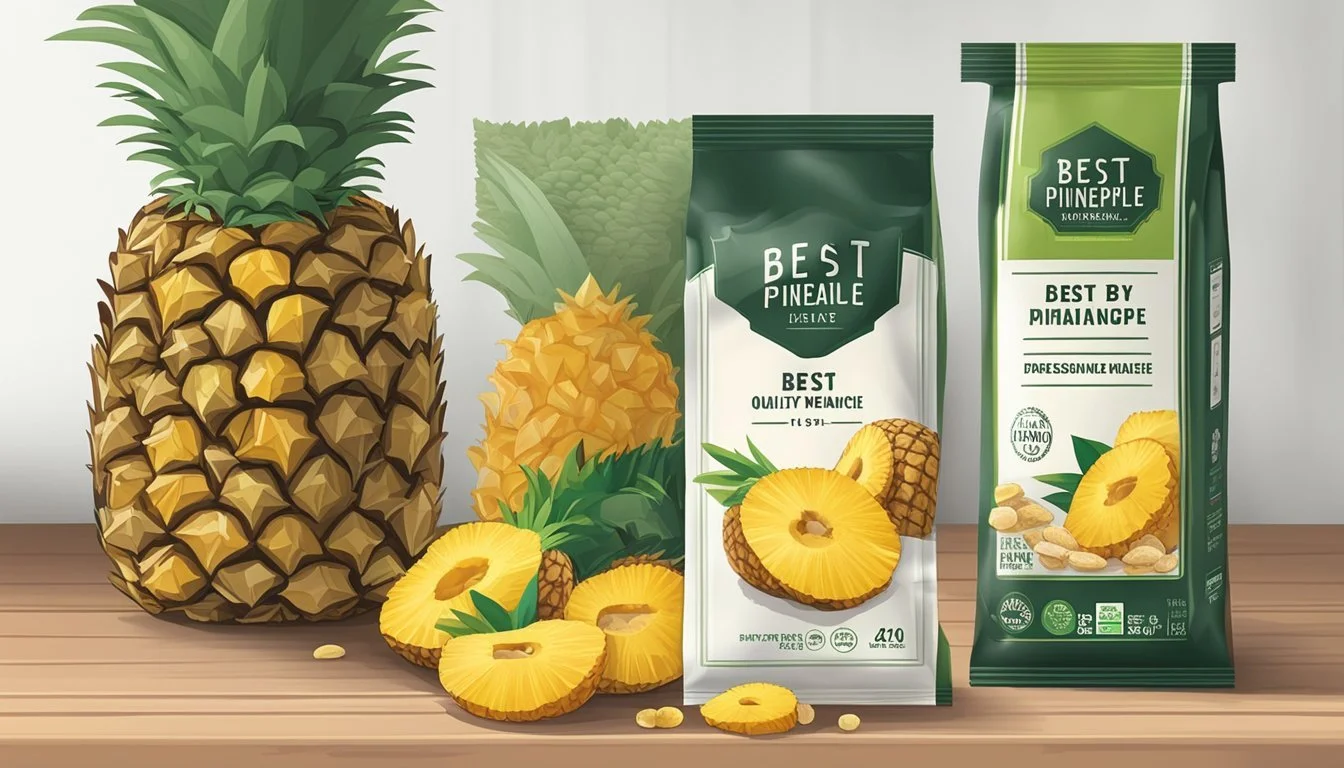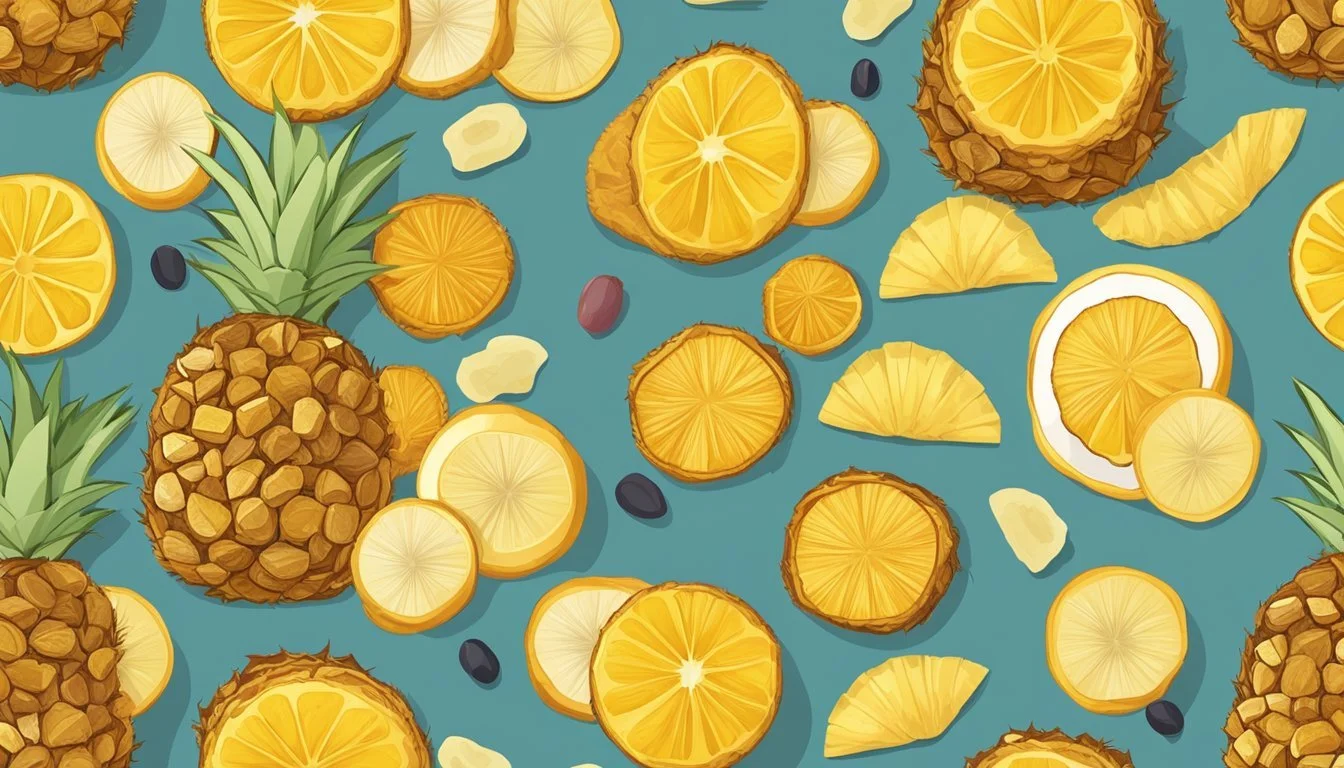How Long Does Dried Pineapple Last?
Unveiling Shelf Life Secrets
Dried pineapple is a popular choice for a healthy snack due to its portability, sweet taste, and nutritional benefits. Enjoyed by those adhering to various diets, it serves not just as a convenient food item but also as a way to preserve the tropical fruit for extended periods. The dehydration process removes water from the pineapple, concentrating its natural sugars (how long does sugar last?) and extending its shelf life significantly compared to its fresh counterpart.
The shelf life of dried pineapple typically ranges from six months to one year when stored at normal room temperature. Key factors influencing its longevity include the method of drying, the presence of preservatives or additives, and the storage conditions. In general, dried pineapple with no additives will have a shorter shelf life than those treated with preservatives.
For individuals living in hot, humid environments, or for those looking to extend the shelf life of their dried pineapple, refrigeration is a recommended storage option. Cool and dry conditions help in maintaining the quality of the dried fruit and can effectively prolong its viable consumption period. Properly sealed and stored, dried pineapple remains a nutritious and delightful option for those seeking a taste of the tropics in their daily diet.
Understanding Dried Pineapple
Dried pineapple is a form of dried fruit where the majority of the original water content has been removed. This preserved state of pineapple retains its natural sugars, concentrated flavors and is a healthy snack alternative to fresh pineapple. Being rich in vitamins like Vitamin A and Vitamin C, it offers a nutritious option, serving as a good source of dietary fiber and supplying essential nutrients with fewer calories than similar-sized portions of candied fruit. (how long does candied fruit last?)The nutrient profile of dried pineapple boasts reasonable amounts of potassium, calcium, and iron, alongside its carbohydrate content. Here is a breakdown of its key nutritional elements per serving:
Calories: moderate
Carbohydrates: high (mainly natural sugars)
Sodium: low
Potassium: moderate
Calcium: low
Iron: low
In terms of shelf life, dried pineapple outlasts its fresh counterpart due to the reduced moisture content, which inhibits the growth of spoilage-inducing microorganisms. It typically has a lengthy storage time of up to one year when kept in a cool, dry place. Refrigeration can further extend this shelf life, especially in humid environments.
It is essential to note that dried pineapple without additives doesn't last as long as those with preservatives. Consumers should confirm the ingredient list for any additional preservatives which could extend the longevity and alter the nutritional value of the dried fruit.
Lastly, dried pineapple remains a favorite for its versatile use in baking, cooking, or as a standalone snack. It is easy to transport and store, rendering it a reliable option for those seeking a sweet yet health-forward treat.
Selection and Preparation
Proper selection and preparation of pineapples are crucial for creating quality dried pineapples. The right pineapple can significantly enhance the flavor profile and texture of the dried fruit, while the preparation process ensures proper drying and preservation.
Choosing the Right Pineapple
When one sets out to pick a pineapple for drying, they should look for fruits that are ripe and heavy for their size. The base of the pineapple should emit a sweet aroma, indicative of the natural sugars present within. A ripe pineapple will have a slightly firm texture but yield slightly under pressure. The color of a ripe pineapple is generally a vibrant green that stretches into a warm yellow, suggesting optimal ripeness.
Preparation Process
Before drying, a pineapple needs to be properly cut and cored. One should use a paring knife to remove the outer skin and the hard core center. The pineapple should then be sliced into even rings or chunks to ensure uniform drying. Ensuring that the pieces are of similar thickness will help maintain a consistent texture in the final product.
Homemade Drying Techniques
For those opting to dry pineapples at home, a conventional oven or a dehydrator can be used. If using an oven, one should place the pineapple on a baking sheet lined with parchment paper. The oven should be set to the lowest setting, generally around 175° F, and the fruit should be turned every couple of hours to dry evenly. The drying process typically takes about 8 hours but can vary depending on the oven and thickness of the pineapple slices. Once dried, pineapple should be stored in a cool, dry area in airtight containers to maximize shelf life.
Optimal Storage Methods
Proper storage is crucial to maintaining the quality and extending the shelf life of dried pineapple. By implementing the right strategies for short-term and long-term storage, and choosing appropriate packaging and containers, the dried fruit can be preserved effectively.
Short-Term Storage
For short-term storage, a pantry or a kitchen cabinet away from direct sunlight is suitable. Dried pineapple should be kept at room temperature in a dry area to ensure it remains flavorful. An airtight container helps minimize exposure to air and humidity, key factors that can degrade the quality of the fruit.
Extending Shelf Life
To extend the shelf life of dried pineapple:
Refrigerate: Storing in the refrigerator can prolong freshness, especially in warmer climates.
Freeze: For long-term storage, freezing is an option. Place the dried pineapple in a freezer-grade, airtight container or resealable bag before storing it at 0°F, where it can be kept safe indefinitely.
Packaging and Containers
Selecting the right packaging and containers is paramount for maintaining the quality of dried pineapple:
Airtight Containers: Store dried pineapple in airtight containers that seal out moisture and air, reducing the risk of spoilage and maintaining taste.
Plastic Bags: Resealable plastic bags are convenient for storage but should only be used if they provide a reliable seal.
Use containers that are free from odors and are food-grade to prevent contamination and preserve the fruit's natural flavors.
Signs of Spoilage
When assessing the quality of dried pineapples, one must pay attention to signs of spoilage that may compromise both the flavor and safety of the fruit.
Visual Indicators
Dried pineapples that are no longer fit for consumption often exhibit a change in appearance. Spoilage may manifest as discoloration or the presence of mold, which appear as white, green, or black spots. Additionally, dried pineapples may stick together in clumps, deviating from their original, dry, and separate state.
Olfactory and Tactile Cues
Odor and texture are critical in determining the condition of dried pineapples. A spoiled product may emit an off-odor, which is unmistakably different from the fruit's originally sweet and tangy smell. The texture may also become either notably sticky or hard, implying a loss of quality and possible hygiene concerns. Handling the pineapple should result in minimal residue left on the fingers, and the pieces should feel dry to the touch. If the tactile experience is anything but this, it is likely the dried pineapples have gone bad.
Health Considerations
When incorporating dried pineapple into one's diet, it is crucial to understand its nutritional benefits and potential risks to make informed health decisions.
Nutritional Benefits
Dried pineapple is a source of numerous nutrients that contribute positively to a balanced diet. It is notably high in manganese, a mineral essential for bone health and enzyme function, and provides a good supply of vitamins such as vitamin C. Additionally, it contains dietary fiber, which can aid in digestion and help maintain a healthy weight when consumed in appropriate portions. As a healthy snack option, dried pineapple offers a condensed source of energy and nutritional value, making it a suitable addition to various dietary needs.
Potential Risks
However, one must be cognizant of the potential risks associated with dried pineapple, particularly due to its high sugar and calorie content which can impact blood sugar levels. Dried pineapple often contains added sugar, increasing the overall calorie count. Hence, consumption should be in moderation to avoid excessive calorie intake. Furthermore, improper storage of dried pineapple can lead to foodborne illness. To mitigate health risks, individuals are advised to store dried pineapple in a cool, dry place and consume it within the recommended shelf life to prevent spoilage. It is crucial for consumers to recognize that while dried pineapple has its place in a healthy diet, it should be considered as part of a larger approach to eating that values a variety of foods and nutrients.
Incorporating Dried Pineapple into Your Diet
Dried pineapple can be a flavorful addition to various recipes and a convenient snack option. Rich in nutrients like fiber and carbohydrates, it should be consumed in moderation due to its sugar content.
Recipe Ideas
Dried pineapple chunks are versatile and can be included in a range of recipes. They work well in tropical-themed dishes, where their sweetness complements ingredients like coconut and almonds. Here are a few specific ideas:
Tropical Smoothie: Blend dried pineapple chunks with coconut milk and a banana for a refreshing drink.
Pineapple Fried Rice: Add them to fried rice for a surprising sweet twist and additional fiber.
Baked Goods: Incorporate chopped dried pineapple into muffins or scones to enhance flavor and texture.
Healthy Snack Alternatives
For those seeking healthier snack options, dried pineapple is a suitable choice, providing essential nutrients such as dietary fiber, manganese, iron, and calcium. It can be prepared as a snack in the following ways:
Trail Mix: Combine dried pineapple with nuts and seeds for a homemade trail mix.
Yogurt Topping: Sprinkle a small amount over yogurt to add natural sweetness without overindulging in sugar.
Remember to enjoy dried pineapple in moderation due to its concentrated sugar content compared to fresh pineapple.
Dietary Variations
Dried pineapple suits various diets, offering a source of carbohydrates and dietary fiber. Those with dietary restrictions can consider these options:
Gluten-Free: Dried pineapple is naturally gluten-free and can be safely consumed by those with gluten intolerance.
Vegan: It is also a vegan-friendly option that can be used to sweeten dishes without animal products.
Diabetic-Friendly: Diabetic individuals should note the sugar content and opt for smaller portions, balanced with proteins or healthy fats to minimize blood sugar spikes.
Consumers should ensure that the dried pineapple they purchase does not contain added sugars or preservatives that could alter its nutritional profile.
Shelf Life and Quality Maintenance
When it comes to dried pineapple, shelf life plays a significant role in quality maintenance. Properly stored dried pineapple generally maintains its best quality for 12-18 months. It's essential to differentiate between the best before date, which indicates peak quality, and the use by date, which is more about safety. Dried pineapple will often remain safe to consume beyond its 'best before' timeline if stored adequately.
Preservatives and additives included in the packaging of dried pineapples can have a substantial impact on their longevity. Pineapples with added preservatives tend to have a longer shelf life than those without. Meanwhile, natural dried pineapple without additives might not last as long.
To ensure optimal preservation of dried pineapple, consider the following storage guidelines:
Packaging: Keep the pineapple in an airtight container or a resealable plastic bag to protect it from moisture and pests.
Environment: Store in a cool, dry place, such as a pantry or kitchen cabinet, away from direct sunlight.
The presence of an expiring ingredient or signs of spoilage should prompt immediate disposal of the product. Degradation in taste, color, or texture can indicate that the dried pineapple is past its prime. Furthermore, persistent freezing at 0°F will keep the pineapple safe indefinitely, with the caveat that quality may decline over time.
One should stay vigilant regarding changes in the dried pineapple's properties, as these can be precursors to spoilage, leading to a necessary assessment of the fruit's edibility.
Understanding Freshness and Ripeness
When selecting a pineapple, its ripeness is a key factor that determines both its taste and longevity. A ripe pineapple is characterized by a bright, fruity aroma at the base, slightly soft to the touch, and has a vibrant, golden-brown skin. The ripeness directly influences the natural sugars, which are at their peak in a ripe pineapple, offering a tangy and sweet flavor profile.
One should know how to pick a pineapple that is ripe but not overripe, as overripeness can lead to a shortened shelf life and possible spoilage. The presence of these sugars contributes to how long a pineapple will maintain its best quality when dried. As pineapples mature, the conversion of starches into natural sugars occurs, and a fully ripe pineapple has a higher sugar content, rendering it more prone to faster decomposition once dehydrated.
Pineapple Condition Expected Shelf Life Fresh and ripe 5 days to 1 week* Dried 6 to 12 months**
It's worth noting that while drying pineapples does extend their shelf life significantly, factors such as storage conditions—like temperature, humidity, and exposure to air—can impact how long dried pineapple retains its freshness. For instance, in a humid environment, dried pineapple's longevity is best preserved by refrigeration.
*Refrigeration recommended for optimal freshness. **Stored at room temperature in an airtight container; may extend shelf life if refrigerated or frozen.
By placing emphasis on the condition of the pineapple at the time of purchase and following proper storage techniques, consumers can enjoy dried pineapple for a longer period of time while savoring the delightful, tangy sweetness it offers.
Comparison with Other Dried Fruits
When comparing dried pineapples to other dried fruits (What wine goes well with dried fruits?), it is essential to consider their nutritional profiles, the texture and flavor differences, and their typical uses in dishes.
Nutritional Profiles
Dried pineapple is rich in vitamins and minerals, especially vitamin C and manganese. In contrast, dried fruits like dried mango and prunes offer different nutritional benefits. Prunes are known for their high fiber content and are a good source of vitamin K and potassium. On the other hand, dried mangoes are also a good source of vitamin C but are higher in calories than dried pineapples. When comparing iron content, dried fruits like prunes stand out as they contribute significantly to the daily iron intake, unlike dried pineapple.
Dried Fruit Vitamin C Iron Fiber Calories Pineapple High Low Low Moderate Mango Moderate Low Low High Prunes Low High High Moderate
Texture and Flavor Differences
The texture of dried fruits can vary significantly. Dried pineapple typically has a chewy texture, and offers a balance of tangy and sweet flavors. Compared to dried pineapple, prunes have a softer, more pliable texture and a naturally sweet yet tart taste. Dried mangoes are also chewy but can be slightly tougher than dried pineapple. Flavor-wise, dried mangoes are distinctly sweet with a hint of tartness, though less pronounced than in dried pineapples.
Uses in Dishes
Dried fruits, including dried pineapple, are versatile ingredients in the kitchen. Dried pineapple can be rehydrated and used in tropical dishes or eaten alone as a snack. It differs from other dried fruits like prunes, which are commonly found in stews and desserts, adding sweetness and a moist texture. Dried mango, with its intense sweetness, is often used in curries and chutneys or as a chewy snack. Unlike canned pineapple, dried pineapple doesn't release excess moisture, making it more suitable for baked goods where a concentrated flavor is desired. In comparison to fresh fruits, all dried fruits offer a longer shelf life and a more concentrated flavor, which can enhance the taste profile when prepared in a dish.










